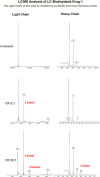Unique challenges required reassessment and alterations to critical reagents to rescue a neutralizing antibody assay
- PMID: 38884331
- PMCID: PMC11389750
- DOI: 10.1080/17576180.2024.2360363
Unique challenges required reassessment and alterations to critical reagents to rescue a neutralizing antibody assay
Abstract
Aim: To redevelop a neutralizing antibody (NAb) assay to be much more drug tolerant, have a large dynamic range and have high inhibition when using high levels of positive control (PC).Materials & methods: Early assay data suggested that typical biotin labeling of the capture reagent (Drug 1, produced in a human cell line) was blocking it from binding with the PC or the detection target, and that the detection target was out competing the PC. Methodical biotin labeling experiments were performed at several challenge ratios and an Fc linker was added to the detection target.Results & conclusion: A larger dynamic range, high inhibition and higher drug tolerance were achieved by adding an acid dissociation step to the assay, performing atypical biotin labeling of Drug 1 and switching to a detection target that contained an Fc linker to increase steric hinderance and decrease its binding affinity to Drug 1.
Keywords: acid dissociation; anti-drug antibody; biolayer interferometry; biotinylation; competition assay; critical reagents; immunogenicity; ligand binding; monoclonal antibody therapeutics; neutralizing antibody.
Plain language summary
Many of the drugs available today are produced by a living organism and these are called biologics. Biologics are larger than chemical drugs and the human body can detect them as foreign and create antibodies against them. This is called immunogenicity. When the antibodies created against the biologic blocks the drug's ability to work correctly, they are called neutralizing antibodies (NAbs). Testing for NAbs is one of the requirements of regulatory agencies for biologics. Here we describe challenges encountered developing an assay to test for NAbs against a biologic.
Conflict of interest statement
The authors have no competing interests or relevant affiliations with any organization or entity with the subject matter or materials discussed in the manuscript. This includes employment, consultancies, stock ownership or options and expert testimony.
Figures






References
-
- Gupta S, Indelicato SR, Jethwa V, et al. Recommendations for the design, optimization, and qualification of cell-based assays used for the detection of neutralizing antibody responses elicited to biological therapeutics. J Immunol Methods. 2007;321(1–2):1–18. doi: 10.1016/j.jim.2006.12.004 - DOI - PubMed
MeSH terms
Substances
LinkOut - more resources
Full Text Sources
Other Literature Sources
